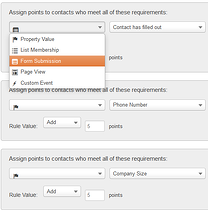 Andrew Capland is a Principal Inbound Marketing Consultant at HubSpot. He works with small to medium-sized businesses to help them achieve success through inbound marketing. This includes assisting them with campaign execution, as well as helping them restructure their marketing and sales teams to become more efficient with inbound techniques.
Andrew Capland is a Principal Inbound Marketing Consultant at HubSpot. He works with small to medium-sized businesses to help them achieve success through inbound marketing. This includes assisting them with campaign execution, as well as helping them restructure their marketing and sales teams to become more efficient with inbound techniques.

As an Inbound Marketing Consultant at HubSpot, I get to work hands on with a lot of our customers on a day-to-day basis. And I get asked this question all the time:

How do we set up custom lead scoring?
HubSpot has a great tutorial on how to set up custom lead scoring, which is the right place to start to understand how the tool works. But outside of understanding how the product works, my answer is usually more of a conversation. Here are a few points that are important to understand before diving into things.
1. Make Sure You Need it First
Lead scoring can be a fantastic way to attach values to each of your leads based on a combination of contact information and behavior. However, lead scoring for the sake of lead scoring isn't going to be helpful. To determine if lead scoring is right for you, you'll need to take a step back and ask yourself a few questions:
- Is your sales team currently getting enough leads? If not, start by focusing on generating more leads.
- Is your sales team calling the leads they're getting today? If not, you might have a marketing/sales alignment issue on your hands.
2. Perform a Content Audit
One of the easiest ways to implement custom lead scoring is to assign different points to the various forms that a visitor can might out on your site. So first, you should take inventory of all of your content that is downloadable via forms and landing pages.
Not all landing pages are created equal
A lead that fills out a sales-related form (like "Request a Quote," "Free Consultation," "Ask an Expert," "Talk to Sales," etc.) is going to be more immediately valuable to your sales team than a lead that fills out a form for an informational or educational offer (such as whitepapers, .pdfs, ebooks, info packs, etc.) and can be assigned more points. So if you're not sure where your content lies, start by performaing a content audit. Which content is likely to be downloaded by your best prospects?
3. Talk to Your Sales Team
You can also assign points for characteristics that your sales team find important. The HubSpot software will allow you to assign points based on any information that lives inside of your HubSpot Contacts database. So if you're integrated with a CRM, you'll have almost unlimited options, and can assign points for any data being stored there.
Some common examples of things you might score are:
- Specific job titles or roles
- Company size
- Phone Number
- Personas
- Specific trade show attendance

Instead of picking criteria that the marketing team thinks is important, why not talk to the sales team, and find out what criteria the sales team thinks is important? Most sales teams know about certain prospect characteristics that are more important than others. Find out what they are, so that you can assign more points when implementing the custom lead scoring system. They'll be the ones using the scoring system to prioritize which leads they'll be calling as part of the inbound sales process. So it makes sense to involve them from the start.
4. Create a Maximum Points System
Now that you've performed a content audit, and talked to your sales team to identify important criteria, you'll want to start assigning points to score the leads. The HubSpot software gives you the flexibility to assign whichever point values you like. But if you're not careful, the resulting scores will start to grow out of control become confusing. To keep it simple, we recommend implementing a 1-100 scale for custom lead scoring. This will keep your scores more managable, and save you headaches down the road.
Take a mental picture of a perfectly qualified sales-ready lead. Now write down that imaginary person's professional information and website behaviors. Maybe it's a lead who's filled out a "Request a Demo" form, who's a Director at a company with 500-1000 employees, and who also gave you their phone number. Maybe this would be a perfect score of 100. You decide. What does your best possible lead look like? Now work backwards, and identify the criteria and behaviors that are most important while assigning point values along the way.
5. Don't Set it in Stone
During the HubSpot consulting process, most people are implementing custom lead scoring for the first time. But this is something that should be fine-tuned over time as you learn more about which website behaviors and lead charasteristics tend to convert into sales more often. Some of this will be based on data that you simply don't have right now. That's okay. As you design your initial scoring criteria, just understand that it will likely change down the road. So don't obsess over making sure it's 100% perfect, since the HubSpot technology makes it perfectly easy to tweak as time goes on.
6. Keep it Simple
Things can get complicated if you try to do too much at once, so my advice is always to start slow, and keep it simple. After you perform your content audit, assign different points to the various landing pages you've designed. Typically, you'll want to assign more values to forms that are deeper in the sales cycle and decision-making process. Have your sales team identify a few key characteristics that help them identify a hot lead, and assign points to those as well.
If you follow these six tips for success, you'll be in great shape to design a custom lead scoring system that's simple, effective, and helps identify your hottest leads for your sales team.
Have any other suggestion that you use in custom lead scoring? Let us know in the comments below.









